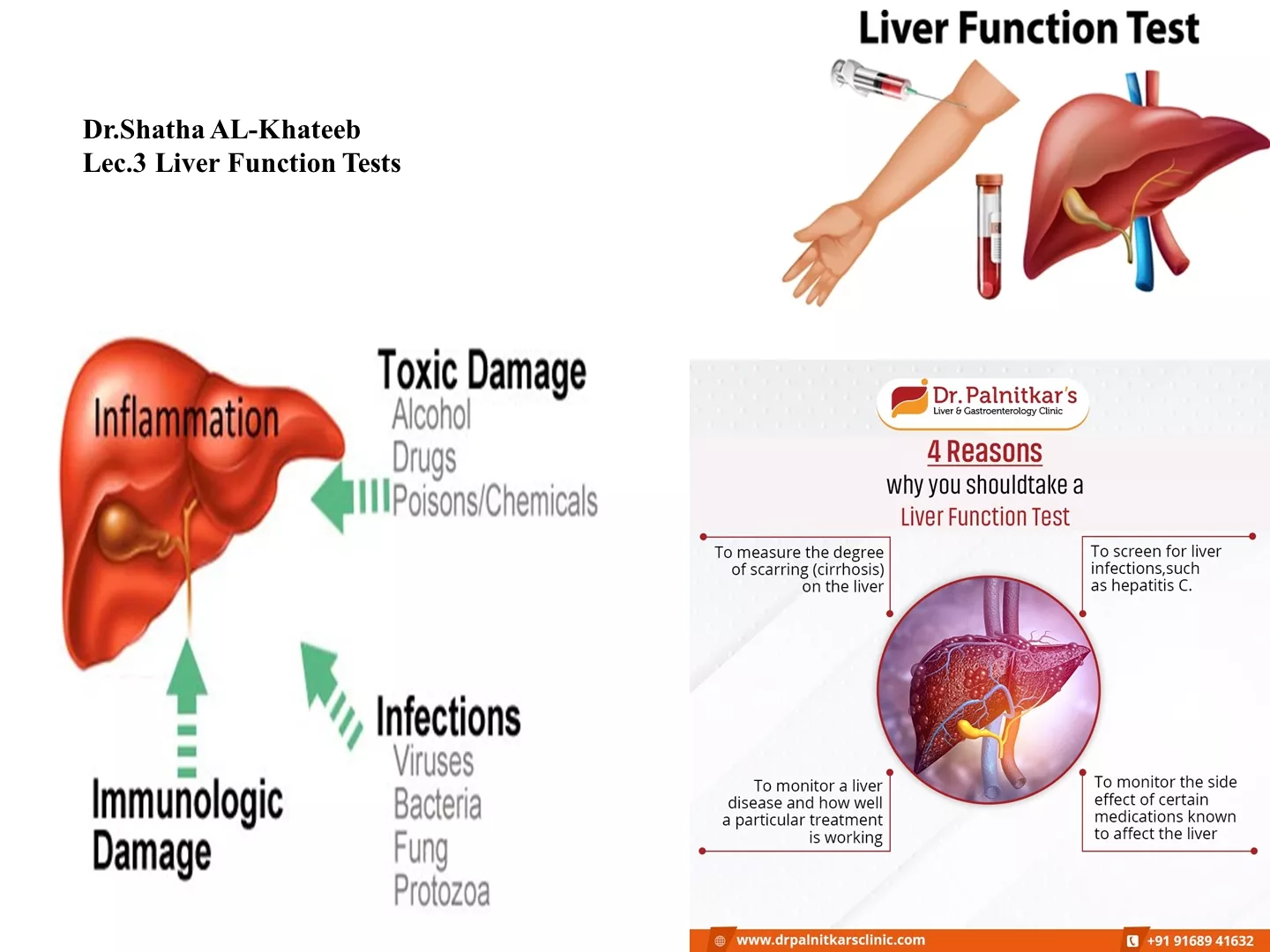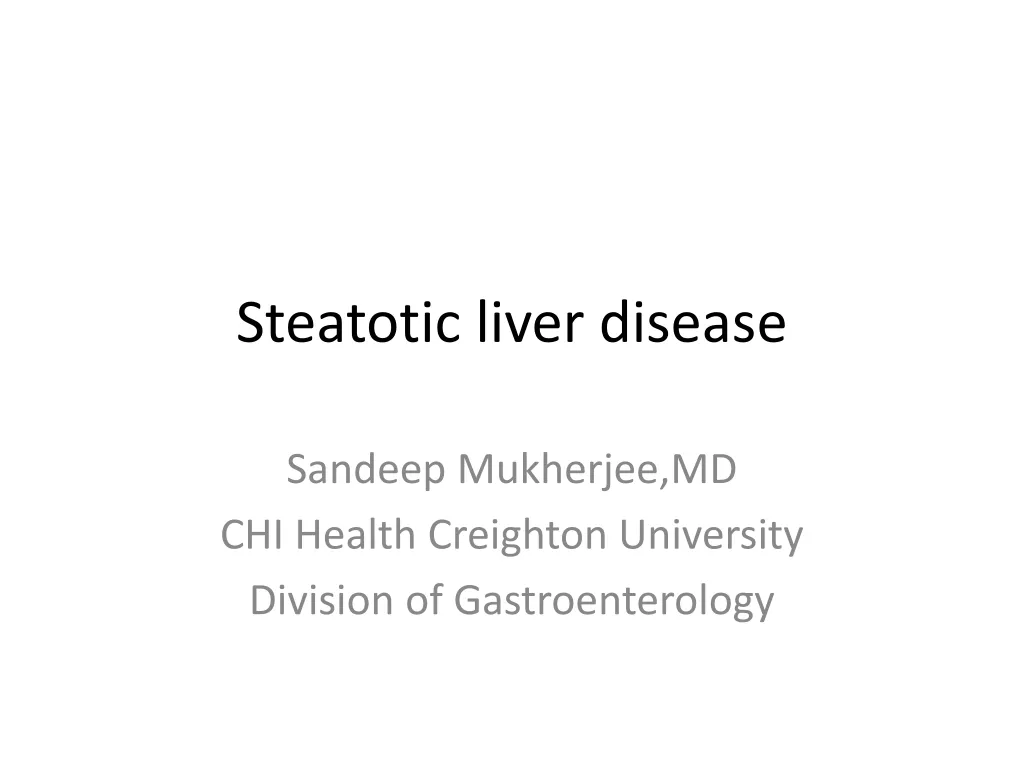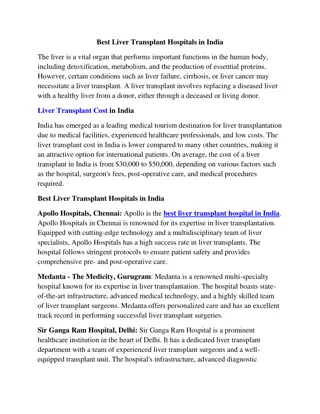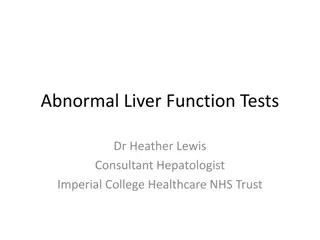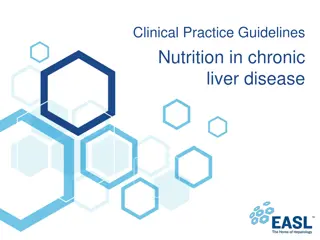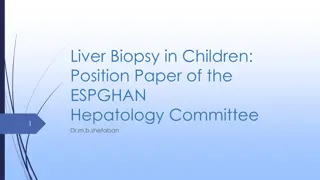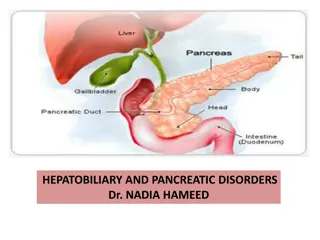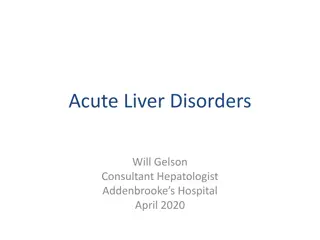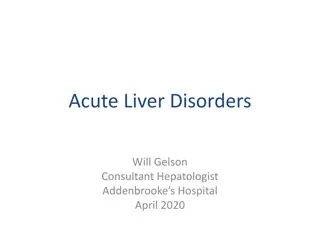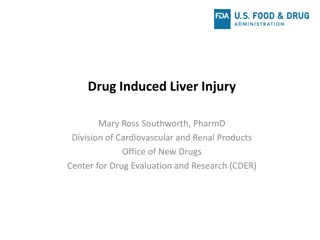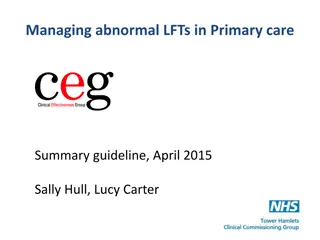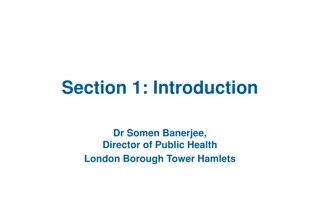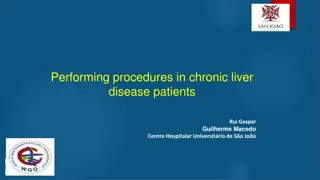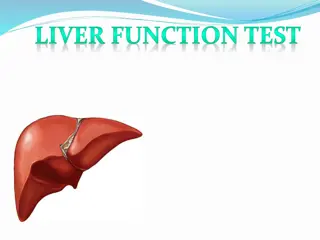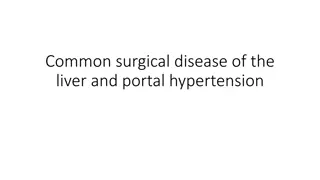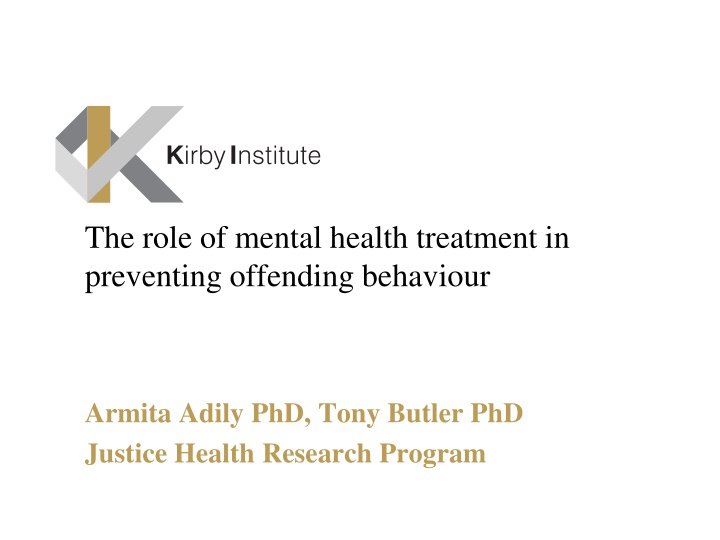
Primary Biliary Cholangitis: Chronic Inflammatory Liver Disease
Primary Biliary Cholangitis (PBC) is a chronic inflammatory autoimmune liver disease affecting small biliary ducts. The disease involves an unknown etiology where immune and biliary pathways interact, leading to chronic inflammation, cholestasis, and liver fibrosis. Loss of immune tolerance, macrophage and T cell activation, impaired bile acid secretion, and activation of stellate cells contribute to the pathogenesis. Peroxisome proliferator-activated receptors (PPARs) and Farnesoid X receptor (FXR) play roles in metabolic regulation and anti-inflammatory properties. Histopathologic features include non-suppurative cholangitis, periductal inflammatory infiltrate, bile duct loss, and fibrosis. PBC is associated with diseases like Hashimoto’s thyroiditis, Sjogren's disease, and celiac disease.
Download Presentation

Please find below an Image/Link to download the presentation.
The content on the website is provided AS IS for your information and personal use only. It may not be sold, licensed, or shared on other websites without obtaining consent from the author. If you encounter any issues during the download, it is possible that the publisher has removed the file from their server.
You are allowed to download the files provided on this website for personal or commercial use, subject to the condition that they are used lawfully. All files are the property of their respective owners.
The content on the website is provided AS IS for your information and personal use only. It may not be sold, licensed, or shared on other websites without obtaining consent from the author.
E N D
Presentation Transcript
The role of mental health treatment in preventing offending behaviour Armita Adily PhD, Tony Butler PhD Justice Health Research Program
Investigators Dr Stephen Allnutt UNSW Australia A/Professor Peter Schofield Hunter New England Health A/Professor Handan Wand - Kirby Institute Dr Azar Kariminia Kirby Institute Dr Grant Sara-NSW Health Mr Luke Grant- Corrective Services NSW A/Professor Don Weatherburn - NSW Bureau of Crime Statistics and Research Mr Olayan Albalawi PhD Candidate - Kirby Institute Ms Nabila Zohora Chowdhury PhD Candidate, Kirby Institute Funder: NSW Mental Health Commission
Presentation Introducing the NSW data linkage study to investigate the association between psychosis and offending Two sub-studies 1. To examine the effectiveness of the NSW Court Diversion Programme on re-offending 2. To examine the effect of contact with health services for mental health treatment on re-offending.
Psychosis A syndrome found in mental disorders such as schizophrenia, delusional disorders, bipolar mood disorder, and some forms of severe depression. The syndrome comprises symptoms reflecting profound disturbances of thought, perception and behaviour.1 12-month treated prevalence in Australia - 4.5 per 1000 people.2 Average annual cost to the Australian health sector - $21,658 per person.3 1Douglass et al. Psychol Bull 2009, 2. Morgan et al. ANZJP 2012, 3 Neil et al. ANZJP 2014 4
Background Psychosis is considered to be a risk factor for criminal offending, particularly violent offending. A meta-analysis of 204 studies showed that psychosis was associated with a 49% to 68% increase in the odds of a conviction for violence, compared with the odds of violence in the absence of psychosis. Victorian register data for 2,861 selected patients with schizophrenia showed that 21% of those with schizophrenia had been convicted of a criminal offence (vs. 8% of controls)2 Swedish linkage study (1988-2000) estimated that individuals with a hospital admission for psychotic disorders committed 5.2% of all violent crimes.3 1. Douglass et al. Psychol Bull. 2009, 2. Wallace. Am J Psychiatry.2004, 3. Fazel & Grann. Am J Psychiatry 2006 5
The Relationship between psychosis and offending Data linkage Study
The relationship between psychosis and offending in NSW Aim Determine the association between psychosis and offending behaviour in New South Wales 7
The relationship between psychosis and offending in NSW Study population A cohort of all individuals who have been diagnosed with psychosis (on admission to a hospital or presentation to an emergency department) in NSW between 1 July 2001 and 31 December 2012. Psychosis types (based on ICD codes): 1. Schizophrenia and related psychosis 2. Affective psychosis 3. Substance related psychosis 8
The relationship between psychosis and offending in NSW Controls For each case, two controls without any record of a diagnosis of psychosis during the study period matched by birth year and sex from NSW Health administrative data collections: 1. 2. 3. 4. 5. 6. 7. 8. NSW Admitted Patient Data Collection NSW Emergency Department Data Collection NSW Registry of Birth, Death and Marriages NSW Mental Health Ambulatory Data Collection NSW Perinatal Data Collection NSW Central Cancer Registry NSW Pap Test Registry NSW Notifiable Conditions Information Management System 9 .
The relationship between psychosis and offending in NSW Primary Outcome At least one offence recorded in the NSW Bureau of Crime Statistic and Research Reoffending Database (ROD)1 from 1 July 2001 to 31 December 2012. 1 Excluding traffic offences 10
The relationship between psychosis and offending in NSW Study Plan A retrospective cohort involving a population level data-linkage using eight administrative data collections in NSW: 1 1. NSW Admitted Patient Data Collection 2. NSW Emergency Department Data Collection 3. NSW Mental Health Ambulatory Data Collection 4. Mental Health Outcomes and Assessment Tool Collection 5. Pharmaceutical Drugs of Addiction System 6. NSW Bureau of Crime Statistics and Research Reoffending Database 7. NSW Offender Integrated Management System 8. The NSW Registry of Births, Deaths and Marriages 1. Linked at the Centre for Health Record Linkage (CHeReL). 11
* Psychosis Cases selected from the APDC & EDDC data collections - 2001-2012 (EDDC 2005 onwards). ** Controls selected from CHeReL s master linkage key (2 controls for each psychosis case matched by sex and age).
Court Diversion and Re-offending
Court liaison/diversion services Court liaison/diversion services developed to intervene with those charged with minor or summary offences with mental illness or cognitive impairment to improve health and justice outcomes All jurisdictions in Australia have some form of court diversion/liaison service* NSW Mental Health [Forensic Provisions] Act 1990 Section 32/Section 33 Treatment order by magistrate: Section 32 treatment orders recommends the person receives community-based treatment and management Section 33 requires the person to be transferred to an inpatient hospital setting. Choice of treatment order based on the perceived risk to the community with the latter considered to pose a greater risk. Studies (mostly US) have found positive outcomes e.g. reduced re-offending, improved living skills, reduced substance use Little evaluation of the NSW Community and Court Liaison Service (SCCLS) * Davidson, F., et al. (2016). A critical review of mental health court liaison services in Australia: A first national survey. Psychiatry, Psychology & Law, 1-14, doi: 10.1080/13218719.2016.1155509.
Section 32 & Section 33 Treatment orders 2001-2012 Section 32 and Section 33 orders and dismissed due to mental illness by finalisation year 1600 1400 1200 Dismissed by the lower courts due to mental illness/health 1000 800 Section 32 600 Section 33 400 200 0 2001 2002 2003 2004 2005 2006 2007 2008 2009 2010 2011 2012 SCCLS: currently operates in 22 courts across NSW
Study design Retrospective study using diagnostic and treatment data from the NSW Health and court and re-offending data from the NSW Bureau of Crime Statistics and Research Reoffending Database (2001-2012) 17
Treatment order group Individuals with diagnosis of psychosis prior to their court finalisation date who were diverted from the courts into treatment for their first principal offence. Comparison group Individuals with diagnosis of psychosis prior to their court finalisations date who received punitive sanction (bond, community order, fine, probation, suspended sentence) for their first principal offence. 18
Outcomes of interest SCCLS sub-study Incidence of the second offence following the first principal offence by sanction type (treatment order vs. punitive sanction) Time to the second offence following the first principal offence by sanction type Predictors of the second offence
Analysis Descriptive analysis to examine the characteristics of the treatment and comparison group Survival analysis and Cox regression models to examine time to re-offend and predictors of re-offending 20
Treatment and comparison groups 7,743 were identified with psychosis prior to their court finalisation for their first principle offence. 1,996 (26%) received treatment order 5,747 (74%) received punitive sanction 21
Characteristics of the treatment order vs comparison (punitive) groups Men: 73% vs 73% Indigenous status: 7% vs 11% Schizophrenia and related psychoses: 81% vs 65% Substance related psychosis: 7% vs 25% First offence (violent): 56% vs 38% 22
Incidence of re-offending (treatment order group vs comparison group) Re-offending in treatment order group: 38% Re-offending in comparison group: 50% Incidence of re-offending by sex: Men in the treatment order group: 6.8 per 100 person-years (95% CI 6.3 7.4) Men in the comparison group: 11.1 per 100 person - years (95% CI 10.6 11.6) Women in the treatment order group: 6.9 per 100 person - years (95% CI 6.0 8.0) Women in the comparison group : 9.6 per 100 person years (95% CI 8.9 10.4) 23
Incidence in treatment and comparison groups by diagnosis Diagnosed with Affective psychosis: Treatment order group: 5.3 per 100 person years (95% CI 4.2 6.6) Comparison group: 7.8 per 100 person years (95% CI 6.9 8.9) Diagnosed with Schizophrenia and related psychoses Treatment order group: 7.0 per 100 person years (95% CI 6.5 7.6) Comparison group: 10.6 per 100 person years (95% CI 10.1 11.1) Diagnosed with substance related psychosis Treatment order group: 8.1 per 100 person years (95% CI 6.4 10.4) Comparison group: 12.3 per person-years (95% CI 11.4 13.2)
Incidence in treatment order and comparison groups by type of first offence Non-violent offence Treatment order group: 7.4 per 100 person years (95% CI 6.7 8.2) Comparison group: 11.6 per 100 person years (95% CI 11.1 12.1) Violent offence Treatment order group: 6.4 per 100 person years (95% CI 5.8 7.1) Comparison group: 9.3 per 100 person years (95% CI 8.7 9.9)
Factors associated with re-offending: offenders with psychosis, 2001 2012 (7,743) Overall (N=7,743) N (%) aHR* (95% CI) P-value Group Punitive sanction group Treatment order group Psychosis type Affective psychosis Schizophrenia and related psychoses Substance related psychosis Age at the first offence <18 years 18 25 years 26 35 years 36 45 years 46 + years Aboriginal No Yes Unknown Marital status Married Other Country of birth Other Australia Unknown First principal offence type Violent Non-violent *Adjusted by age, marital status, country of birth and psychosis type. 5,747 (74) 1,996 (26) 1 0.68 (0.62 0.74) <0.001 796 (10) 5,351 (69) 1,596 (21) 1 1.19 (1.05 1.34) 1.46 (1.27 1.67) 0.005 <0.001 <0.001 <0.001 <0.001 <0.001 69 (1) 1,586 (20) 2,635 (34) 2,095 (27) 1,358 (18) 2.26 (1.65 3.09) 1.57 (1.40 1.77) 1.64 (1.47 1.83) 1.34 (1.19 1.50) 1 6,176 (80) 773 (10) 794 (10) 1 1.85 (1.68 2.03) 0.08 (0.06 0.11) <0.001 <0.001 959 (12) 6,784 (88) 1 1.21 (1.09 1.35) <0.001 1,339 (17) 5,343 (69) 1,061 (14) 1 1.18 (1.08 1.30) 1.27 (1.12 1.45) <0.001 <0.001 3,288 (43) 4,455 (57) 1 1.20 (1.12 1.28) <0.001 29
Conclusion Diversion into treatment is associated with significant lower rates of subsequent re-offending in men and women regardless of type of offence (violent vs non-violent) of type of psychosis. Less people from Indigenous background were in the treatment order group. This study provides insights into Magistrates sentencing patters. 30
Clinical contact with health services associate with treatment of mental illness and Re-offending
Clinical contact with health services associated with treatment and re-offending Cohort All individuals in New South Wales who were admitted to a hospital or presented to an emergency department with a diagnosis of psychosis before their first offence between July 2001 and December 2005 and received a non-custodial sentence or no penalty for their first offence 32 .
Study plan Treatment group Individuals with a diagnosis of psychosis prior to their court finalisation date between July 2001 and December 2005 who had one or more clinical contact with health services (i.e., hospital admission, community mental health service, emergency department) for mental health treatment between July 2001 and December 2008 (follow- up period) Comparison group Individuals with diagnosis of psychosis prior to their court finalisation date between July 2001 and December 2005 who had no clinical contact with health services for mental health treatment during the follow up period 33
Analysis Descriptive analysis to examine the characteristics of the treatment and comparison group Survival analysis and Cox regression models to examine time to re-offend and predictors of re-offending 34
Outcomes of interest (treatment vs comparison group) during the follow up period (2001 2008) 1. 2. 3. Incidence of re-offending Time to re-offending Predictors of re-offending 35
Characteristics of clinical contact vs no clinical contact groups N = 2,724 Men: 74% vs 75% Indigenous status: 8% vs 8% Schizophrenia and related psychosis: 77% vs 62% Substance related psychosis: 14% vs 28% First offence (violent): 36% vs 28% 36
Court outcome for first offence 18.8% dismissed for mental illness Dismissed by the lower courts due to mental illness/health (8.9%) Section 32 dismissal persons suffering mental illness or condition (8.4%) Section 33 dismissal mentally ill persons (1.5%) 37
Contact with health services for mental health treatment during follow-up (July 2001 December 2008) 70% had clinical contact with health services for mental health treatment during the follow up. The median time of first contact with health services for mental health treatment following the first offence was 50 days (IQR: 4 199.5 days). First contact with health services Community mental health service (52%) Hospital admission (47%) Emergency Department (1%) 38
Number of contact with health services for mental health treatment during the follow up (July 2001 December 2008) Median number of clinical contacts with health services during the follow up: 22 times (IQR 4 99) Number of contacts 0 1-14 15 30 31 40 41+ (30%) (31%) (8%) (4%) (28%) 39
Type of health services contacted during the follow up for treatment of mental health problem (July 2001 December 2008) Community mental health services (96.1%) Hospital admission (3.5%) Emergency Departments (0.4%) 40
Factors associated with clinical contact with health services for treatment of mental health problem during the follow up Total One or more clinical contacts No clinical contact p-value Characteristics N=2,724 (%) N =1,895 (70%) N=829 (30%) Age at the first offence Mean (years), (SD, range) 33 (10, 12-82) 33 (10,12-82) 32(11,12-74) 0.024 Type of psychosis Affective psychoses Schizophrenia and related psychoses <0.001 253 (9) 1,976 (73) 169 (9) 1,466 (77) 84 (10) 510 (62) Substance related psychoses Type of first offence (2001-2005) Non-violent Violent 495 (18) 260 (14) 235 (28) <0.001 1,819 (67) 905 (33) 1,219 (64) 676 (36) 600 (72) 229 (28) 41
Incidence of re-offending during the follow up period Incidence of re-offending in no clinical contact group: 32.0 per 100 person-years (95% CI 29.5 34.8) Incidence of re-offending in those with one or more clinical contacts: 12.7 per 100 person-years (95% CI 11.9 13.9) Re-offending was 44% less for those with clinical contact for mental health treatment than those with no contact (aHR 0.44; 95% CI 0.40-0.49) 42
Time to re-offend (clinical contact group vs no clinical contact groups) 43
Time to re-offend (clinical contact vs no clinical contact groups with violent or non-violent first offence) 44
Predictors of re-offending in men and women during the follow up Men aHR (95% CI) Women p-value aHR (95% CI) p-value Characteristics Age at first offence 1.55 (1.17-2.03) 1.64 (1.27-2.10) 1.63 (1.29-2.07) 1.22 (0.95-1.57) 1 1.46 (0.87-2.46) 1.73 (1.06-2.83) 2.40 (1.53-3.76) 1.60 (1.01-2.54) 1 0.154 0.029 <0.001 0.047 <18 years 18-25 years 26-35 years 36-45 years 46+ years Type of psychosis 0.002 <0.001 <0.001 0.121 1 1 Affective psychosis 1.16 (0.89-1.51) 0.284 1.50 (1.04-2.17) Substance related psychosis 0.031 Offence type (first) 1 1 Violent Non-violent Contact with health services 1.24 (1.08-1.41) 1.10 (0.87-1.38) 0.425 0.002 1 1 No Yes Number of treatment 0.43 (0.38-0.49) 0.45 (0.36-0.56) <0.001 <0.001 4.53 (3.75-5.48) 3.02 (2.50-3.66) 1.95 (1.47-2.59) 1.67 (1.12-2.48) 1 3.67 (2.73-4.94) 2.61 (1.92-3.55) 1.84 (1.15-2.91) 0.97 (0.47-2.02) 1 0 1-14 15-30 31-40 41+ <0.001 <0.001 <0.001 0.012 <0.001 <0.001 0.010 0.935 45
Predictors of re-offending by type of offence during the follow up Violent first offenders Non-violent first offenders aHR (95% CI) p-value aHR (95% CI) p-value Characteristics Gender Female Male 1 1 0.98 (0.78-1.22) 0.848 1.08 (0.93-1.24) 0.340 Age at first offence <18 years 1.54 (1.00-2.36) 1.48 (1.10-2.00) 0.047 0.010 1.49 (0.98-2.26) 0.058 1.70 (1.30-2.22) 18-25 years <0.001 1.65 (1.12-2.42) 1.81 (1.41-2.32) 26-35 years 0.011 <0.001 1.29 (0.86-1.92) 0.218 1.30 (0.99-1.69) 0.055 36-45 years 1 1 46+ years Indigenous status No Yes 1 1 1.36 (1.00-1.84) 1.06 (0.84-1.34) 0.629 0.048 Contact with health services 1 1 No Yes 0.46 (0.37-0.57) 0.43 (0.38-0.49) <0.001 <0.001 Number of treatment 0 4.11 (3.09-5.47) 4.30 (3.54-5.21) <0.001 <0.001 2.84 (2.14-3.74) 2.93 (2.41-3.57) 1-14 <0.001 <0.001 2.51 (1.69-3.75) 1.65 (1.21-2.23) 15-30 <0.001 0.005 2.03 (1.24-3.34) 1.09 (0.66-1.80) 0.736 31-40 0.005 1 1 46 41+
Conclusion <19% of the offenders with a diagnosis of psychosis received court treatment order between July 2001 and December 2005 (low?). 70% of the cohort had [clinical] mental health service contact 96.1% of clinical mental health service contacts occurred at the community mental health services Risk of re-offending was 44% less for those who clinical mental health service contact compared with those who had no clinical contact. Risk of re-offending decreased with increased number of clinical contacts Attention should be paid to treatment for those with substance related psychosis (especially women) 47

